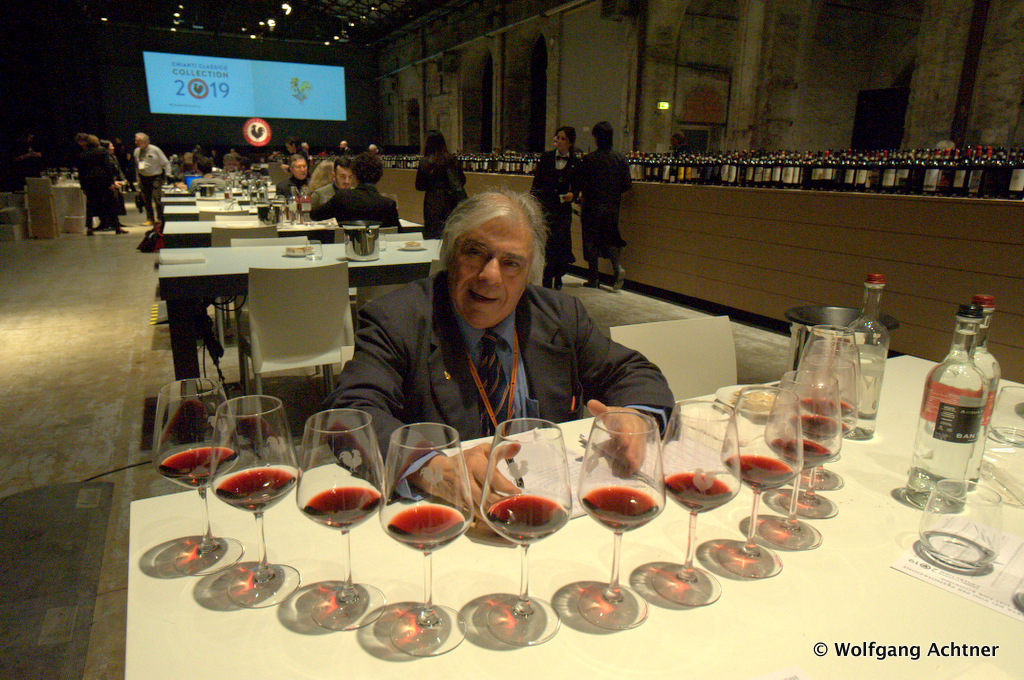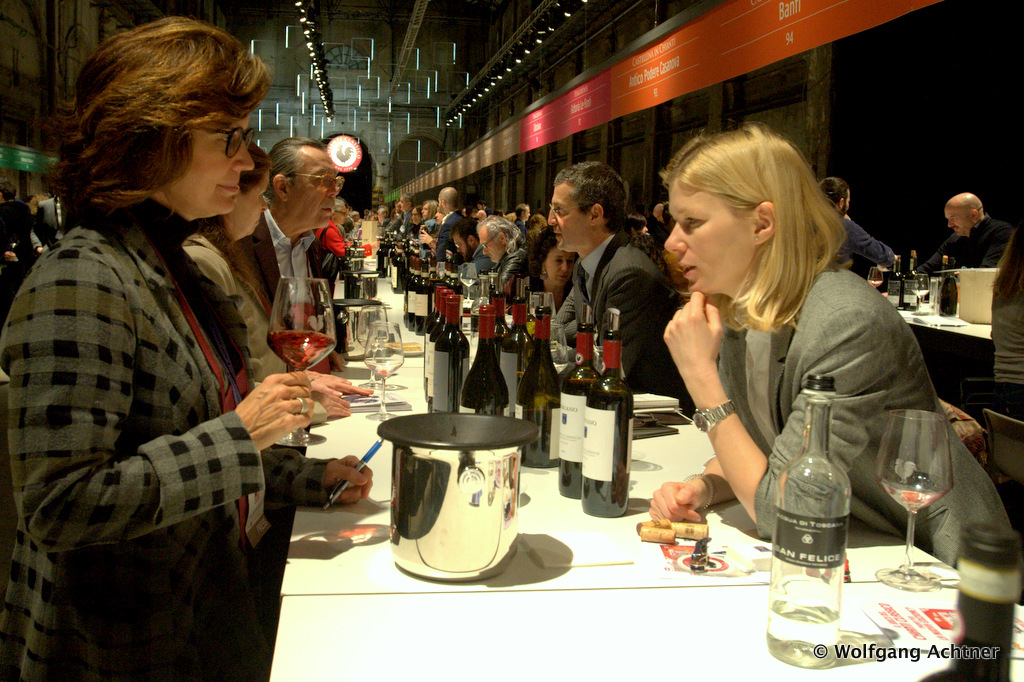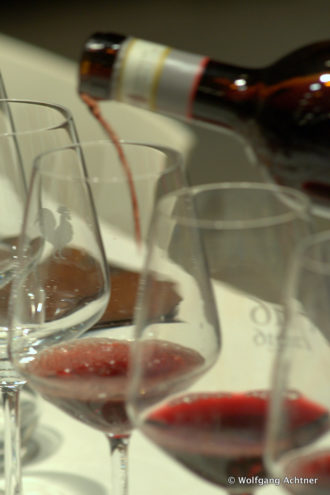On February 11th and 12th, the most important event dedicated to the tasting of Chianti Classico wine was held in Florence. At the Leopolda Station the most recent vintage years of the three types of Chianti Classico, Annata (minimum 12 months aging) 2017, 2016, Riserva (minimum 24 months aging, including 3 months of bottle aging) 2016, 2015, and Gran Selezione (minimum 30 months aging, including 3 months of bottle aging) 2016 and 2015.

Participants at the XXVI edition of the Chianti Classico Collection were welcomed by an image of a huge black rooster made of Sangiovese grapes.
A record number of producers took part in this edition of the “Collection.” There were 197 producers, presenting 721 labels for a total of more than 9,500 bottles on offer for tasting. Over the course of two days, the bottles were opened and poured directly by the producers and a team of 50 sommeliers. 250 journalists from 30 countries were accredited to the event, also attended by more than 1,800 Italian and foreign wine traders.

We should mention that the Consorzio del Chianti Classico is the oldest in Italy and that it was created to protect Chianti wine and its territory.
Chianti wine, known and appreciated for centuries, was protected as early as 1716 by Cosimo III, Grand Duke of Tuscany, who issued a proclamation establishing the confines within which this wine could be produced. This is the first historical legal document instituting a wine production area.

Chianti wine became so important and famous that the winemakers producing it decided to unite to defend it. Two centuries after the initial proclamation, on 14 May, 1924, a group of 33 producers met in Radda in Chianti and formed the Consortium for the defense of Chianti wine and of its brand of origin (Consorzio per la difesa del vino Chianti e della sua marca d’origine). The symbol chosen at that time was the Black Rooster, the historic symbol of the Chianti Military League, founded in the14th century. This symbol had been painted by Giorgio Vasari on the ceiling of the Salone dei Cinquecento in Palazzo Vecchio, in Florence.

Finally, the term Classico was added in 1967, to identify the Chianti Classico territory and wine – because the wine from those areas had become so famous that it was being produced in other areas of Tuscany.
Today, the Chianti Classico Consortium continues to work towards the same ends as always, to protect, preserve and uphold the prestige of this famous wine.

The characteristics of the climate, terrain, and altitudes, which are unfavorable for most crops, have made Chianti a region that excels in the production of premium wines.
Rows of vines alternating with olive orchards are a characteristic feature of the Chianti landscape. About 7,200 hectares (17,290 acres) of vineyards are registered on the DOCG Register for the production of Chianti Classico, making this appellation one of the most important in Italy.
Chianti Classico wine is produced with at least 80% (but sometimes also 100%) Sangiovese grapes. Chianti Classico can be blended with red grapes from other vines, starting with native ones like Canaiolo Nero and Colorino, as well as important international vines like Merlot and Cabernet Sauvignon.

The main markets for Chianti Classico are the United States (34% of sales) followed by Italy (23%), Canada (11%), Germany (8%), Scandinavia, the UK, Switzerland, Germany, Benelux, China, Hong Kong, Russia, and France.
“We are very satisfied with the affirmation of Chianti Classico on the international markets,” said Giovanni Manetti, president of the Consortium, “and, in particular, with the positive trend of the United States and Canada and the stability of all the other historical markets for Gallo Nero wines. I am also very pleased with the result of the domestic market, which rewards the long work of repositioning the denomination over the years that was crowned with the introduction of the Gran Selezione, the new type of Chianti Classico introduced on the market in 2014. There is still much more that can and must be done, and it is one of the main objectives of my term as President to continue to boost the prestige of the denomination, contributing to consolidating its value and image in the world’s oenological excellence sector.”
Inside the Leopolda Station, the high-ceilinged space was separated by heavy curtains into two large and parallel areas, like the naves of an ancient cathedral: the left side was reserved for the winemakers and their visitors, while the right side was reserved for the tasters. In the latter, members of the news media and specialized publications were assisted in tasting the vintage Chianti Classico, the Riserva and the Gran Selezione wines by a group of sommeliers belonging to the AIS (Italian Sommelier Association). The journalists were allowed to enter the area on the left to meet the producers in their respective stands, but in order to make sure that no one was able to influence the judgment of the media, winemakers weren’t permitted to enter the area on the right.
In the nave on the right, there is a very long table in the middle of the room, on top of which there are thousands of wine bottles arranged in tight fitting rows. At a small side table Italian journalist Virgilio Pronzati is seated facing a semicircle of 11 wine glasses, inside each of which there is a small quantity of wine, poured from one of the 721 labels available for tasting.
“During the course of these two days, I’ll taste them all,” says Pronzati motioning towards the table at the center of the nave. “I feel that it is my duty, otherwise how could I write about the wines if I haven’t tasted them?”.

In the producers’ nave, I met Michael Schmelzer a 43-year-old American winemaker who lives in Panzano in Chianti, in the province of Florence. Michael is the owner of the Monte Bernardi company, that has 15 hectares, producing approximately 70,000 bottles a year, of 5 different types of wine. 55,000 of these are “Retromarcia,” “Reverse gear,” a Chianti Classico made of 100% Sangiovese grapes. Its 2017 vintage was presented at the Collection along with “Sa’etta,” “Lightning bolt,” a Chianti Classico Riserva also produced with 100% Sangiovese.
“Initially, I was more interested in cuisine, then after meeting several winemakers, I became more interested in wine. I arrived here at the beginning of the 2000s. My parents were about to retire and they were considering somewhere France and Italy, and at the same time my sister and I were considering becoming winemakers. We decided to set up in the area of Chianti Classico because I thought that this wine had a great potential that was still untapped. I decided to call our vintage year wine “Retromarcia,” “Reverse gear” because I wanted to look to the past, I wanted to make Sangiovese as it used to be made, without makeup or any kind of tricks.”


According to a majority of experts, the 2016 vintage can be considered almost perfect, certainly among the best of the recent decades. On the website Cronachedigusto.it, Federico Latteri wrote, “Regular climate conditions and a perfect ripening period have made it possible to harvest high-quality grapes. The wines are balanced, elegant and endowed with excellent aging potential. Instead, the following vintage, 2017, had to cope with a low availability of water that created great stress for the plants and is responsible for a marked decrease in production. Nevertheless, the tasted wines – even if they didn’t reach the levels of the 2016 vintage – were better than expected, harmonic and balanced but still in evolution, with pronounced tannins, but still good with a typical Chianti Classico character. In general, we’ve noticed that there has been an abandonment of structured products in favor of elegance, drinkability and the typical characteristics that have ensured the worldwide success of this wine.”
The significance of the Collection was underlined by Giovanni Manetti, the President of the Consorzio Vino Chanti Classico. “We’ve had an opportunity to present the results of our work to an extremely qualified group of visitors. We do it with a certain amount of excitement and we are well aware of the fact that our efforts must be characterized by the protection of the quality of our wines and the respect for our territory, not only to obtain great wines and the results that the public and the critics have bestowed on us for many years but also to perform our daily work with the greatest enjoyment.”











